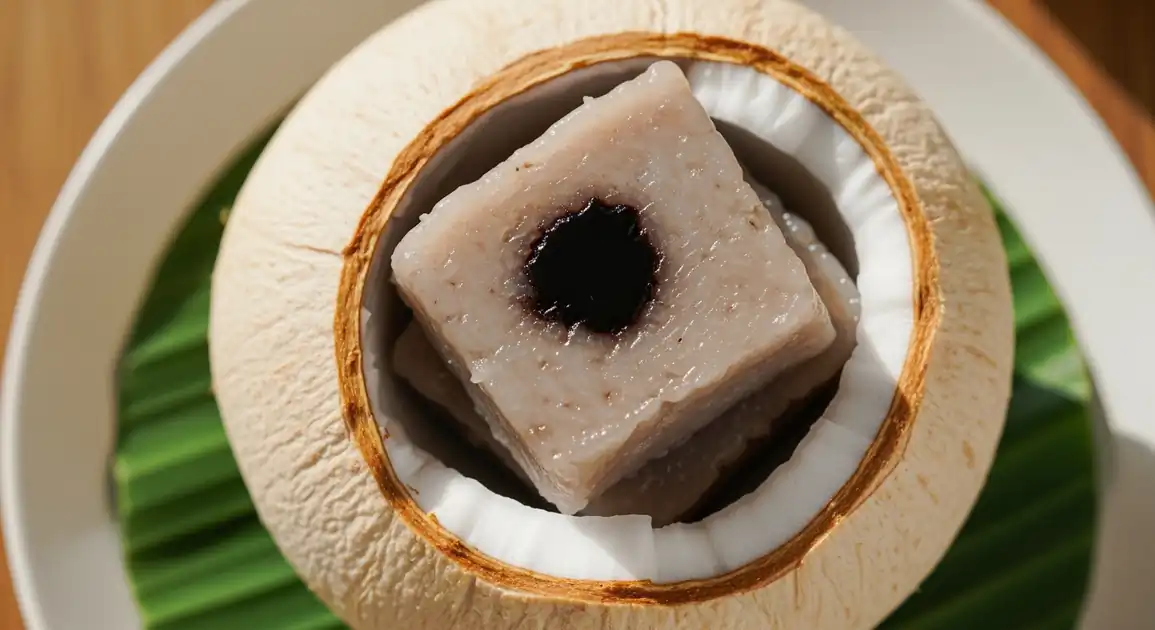Binagol
Binagol

Description
While not originating in Bohol, Binagol is often available in pasalubong centers and some markets in Tagbilaran City, catering to tourists and locals familiar with Visayan delicacies. It's typically brought in from its home region of Leyte/Samar.
Dietary Information
Serving information
Serving style
Sold as individual units in coconut shells, eaten at room temperature with a spoon.
Quick facts
Safety Tips
What to Look For
-
Intact coconut shell packaging
Ensures the contents haven't been exposed or tampered with. Avoid cracked or damaged shells.
-
Secure banana leaf seal (if present)
Helps maintain freshness and indicates proper packaging.
-
Purchased from a reputable vendor
Trustworthy pasalubong centers or market stalls known for fresh products are safer bets than unknown sources.
-
Moist, slightly glossy appearance
Indicates freshness. Avoid Binagol that looks excessively dry or dull.
-
Pleasant sweet, coconutty smell
Should smell appetizing. Any sour, moldy, or off-putting odor indicates spoilage.
What to avoid
-
Cracked or damaged coconut shell
Compromises the integrity and safety of the product.
-
Visible mold on the shell, leaves, or product itself
Clear sign of spoilage; do not consume.
-
Sour or rancid smell
Indicates the product has gone bad.
-
Excessively dry or hardened appearance
Suggests it might be old or improperly stored.
-
Buying from dubious or unknown street vendors (unless highly recommended)
Pasalubong centers or established market stalls offer better traceability.
Price information
Price range
Budget tips
- Prices might be slightly higher than in Leyte/Samar due to transport costs. Expect 100-220 PHP.
- Compare prices between different pasalubong shops.
Value indicators
- Sold in reputable pasalubong centers near the port or airport.
- Shell and seal are intact.
- Vendor can state when the stock arrived.
Where to Find This Dish
Tagbilaran City Pasalubong Centers
Shops near the seaport, airport, and major malls specializing in Boholano and other Visayan delicacies.
Tagbilaran Port, Bohol-Panglao International Airport, Island City Mall vicinity
Store hours
Tagbilaran Public Markets
Potentially found in stalls selling 'kakanin' within Dao Integrated Bus Terminal Market or City Central Market, though less common than dedicated pasalubong shops.
Dao Integrated Bus Terminal, Tagbilaran City Central Market
Morning market hours
Vendor Tips
- Confirm the origin if seeking authentic Leyte/Samar Binagol.
- Check freshness, as items are transported to Bohol.
- These centers also sell famous Bohol delicacies like Calamay and Peanut Kisses.
How to Order
Cultural context
History
Binagol originated in the islands of Leyte and Samar in the Eastern Visayas region of the Philippines. The name 'Binagol' is believed to derive from the Waray word 'bagol', meaning coconut shell. It's a traditional 'kakanin' (native delicacy) often prepared for fiestas, special occasions, and as a valued gift, showcasing local ingredients like taro (gabi), coconut, and glutinous rice. Its unique cooking method within the shell helped preserve it slightly longer.
Local significance
Represents inter-island trade and the popularity of Visayan delicacies across the region. Purchased primarily as a pasalubong item in Bohol.
Eating customs
- Consumed as a snack or dessert.
- Often taken home rather than eaten immediately.